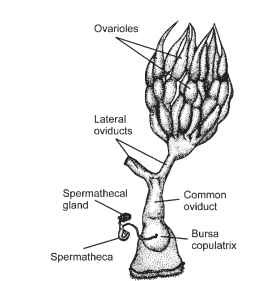Spermatheca
The spermatheca is a special pouch in the female in which spermatozoa are stored and maintained after mating. In more advanced insects, the male deposits seminal fluid or a spermatophore into the bursa copulatrix, and the sperm then move from the bursa into the spermatheca. The sperm often remain viable within the female’s spermatheca for her entire life, which may be as long as 3-4 years for social insects such as the honey bee queen. The sperm are released from the spermatheca only when eggs pass down the oviduct, so fertilization may occur just before the eggs are laid.
SPERMATHECAL STRUCTURE
A female insect typically has only one spermatheca, but some coleopterans have two, and there are three spermathecae in some dipterans. These multiple storage organs may allow the female to segregate and manipulate the sperm. The spermathecae vary considerably in their overall structure from insect to insect, but as outgrowths of the median oviduct, they are all ectodermal in origin and produce a cuticular lining. They generally arise from the median oviduct near or on the genital chamber (Fig. 1). The spermathecal sac (or receptaculum seminis) is connected to the genital chamber by a secretory duct (or ductus seminalis) through which the sperm are discharged. There also may be specialized secretory cells associated with the capsule that produce secretions that maintain the viability

FIGURE 1 The generalized structure of the female reproductive tract, showing the location of the spermatheca.
of the sperm and activate them. The sperm move quite actively within the spermathecal sac, and the secretions of the secretory cells are assumed to provide nourishment to them. Antioxidative enzymes in the spermathecae may protect the sperm from oxidative damage. Secretions of the spermatheca may also be directed into the hemo-coel. In the blood-sucking bug, Rhodnius prolixus, a factor produced by the sperm-filled spermatheca is responsible for the increased rate of egg development that is associated with mating.
UTILIZATION OF SPERM
The spermatheca may be innervated by nerves that branch from the terminal abdominal ganglion and control the release of sperm. When sensory receptors on the oviduct are activated by the presence of an egg, a reflex arc through the terminal abdominal ganglion activates a motor neuron that triggers the contraction of muscles surrounding the spermathecal sac. Sperm are squeezed through the spermathecal duct to the oviduct, where the egg is fertilized before it passes out of the body.
There may not always be a random utilization of sperm present in the female spermatheca. When sequential matings occur, although the sperm from different males may be mixed within the storage organ, the sperm from one mating may be used preferentially. Most often there is precedence in the utilization of sperm so that the last sperm to enter are the first ones to leave, increasing the probability that a second mating will be used to fertilize the eggs. To ensure paternity in second matings to an even greater degree, male insects have evolved some novel mechanisms of sperm displacement. For example, the male of the damselfly, Calopteryx maculata, uses its scooplike penis both to transfer its own sperm to the female and also to remove from the spermatheca sperm from a previous mating. An unusual method of insemination and sperm storage occurs in some members of the heteropteran superfamily Cimicoidea, which includes the bedbugs. Males puncture the cuticle of the female, injecting the sperm into a specialized tissue mass there. The sperm may then move to the ovaries or remain within the tissue mass for storage, as if in a spermatheca.
